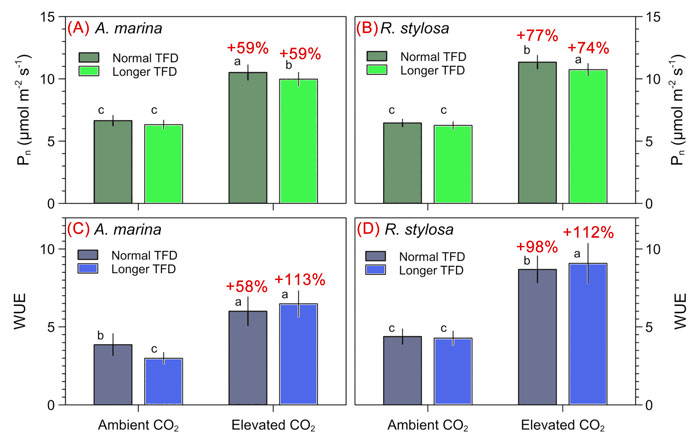The Interactive Effects of Elevated CO2 and Tidal Flooding Duration on Two Mangrove Species
Paper Reviewed Jacotot, A., Marchand, C., Gensous, S. and Allenbach, M. 2018. Effects of elevated atmospheric CO2 and increased tidal flooding on leaf gas-exchange parameters of two common mangrove species: Avicennia marina and Rhizophora stylosa. Photosynthesis Research 138: 249-260. Writing as background for their study, Jacotot et al. (2018) say that “future climate change could affect the functioning of mangrove ecosystems, such as their productivity and carbon sequestration capacities, or even their ability to conquer new available spaces.” Thus, it was their objective to examine the interactive effects of elevated CO2 and increased tidal flooding on two mangrove species, Avicennia marina and Rhizophora stylosa. Their experiment was conducted in controlled-environment greenhouses in the city of Mont-Dore in New Caledonia from June 2016 through May 2017. Two-year-old seedlings of the two mangrove species were grown in the greenhouses under ambient (400 ppm) or elevated (800 ppm) CO2, with the elevated CO2 being supplied during 0500 to 1900 hours each day. In addition, the plants were subjected to normal (3.25 hours for A. marina and 6.0 hours for R. stylosa) or increased (an extra 1.75 hours) tidal flooding durations to simulate what the authors describe as “realistic” durations of tidal flooding under expected end-of-the-century sea level rise projections. The findings of the analysis can be summed up in three of the Result section headings of their paper: (1) “Elevated atmospheric CO2 concentrations will increase mangrove net productivity,” (2) “Increase in temperature will raise the beneficial effect of elevated CO2,” and (3) “Elevated CO2 will help mangrove trees to resist drought.” With respect to the first and third headings listed above, Figure 1 displays the effects of elevated CO2 and tidal flooding on net photosynthesis and water use efficiency of A. marina and R. stylosa. As shown, elevated CO2 induced a 59% increase in net photosynthesis in A. marina regardless of tidal flooding duration, whereas for R. stylosa net photosynthesis increased by 77% under normal flooding and by 74% under longer-duration flooding. What is more, Jacotot et al. report that elevated CO2 did not influence dark respiration, adding that “no downregulation [of photosynthesis] was observed.” Similar findings were noted for water use efficiency, where elevated CO2 increased this parameter by 58% and 113% in A. marina and by 98% and 112% in R. stylosa under normal and longer tidal flooding durations, respectively. The increased water use efficiency was the combined result of increased photosynthesis and decreased transpiration rates in both mangrove species under elevated CO2. Consequently, the authors note that the observed improvement of water use efficiency at higher CO2 should help these mangrove species “resist drought episodes.” With respect to their reporting that warming temperatures will enhance the beneficial effects of CO2 enrichment of the two mangrove species, Jacotot et al. write that the positive effects on photosynthesis were “more pronounced during the warm season, suggesting that an increase in global temperatures would further enhance the photosynthetic response of the considered species,” noting that there was “a clear difference in the photosynthetic response to elevated CO2 between the cool season and the warm season, which increased from 32 to 40% and from 38 to 45% for A. marina and R. stylosa, respectively.” Lastly, the authors report that the increase in tidal flooding duration had no statistically significant impact on net photosynthesis for either mangrove species under ambient CO2 and that it had only a very small effect (3-5% decline) under elevated CO2 conditions. Consequently, in light of all of the above, the future looks very promising for the growth and survival of these two mangrove species.
 Figure 1. Mean values ± SEM (n = 360) of net photosynthesis (A, B) and water use efficiency (C, D) for A. marina and R. stylosa grown in ambient (400 ppm) or elevated (800 ppm) CO2 and under normal (dark green or blue) and longer (light green or blue) tidal flooding durations for 12 months. Different letters indicate significant differences (p < 0.05) and red percentages indicate the percent change in net photosynthesis (Pn) or water use efficiency (WUE) due to elevated CO2 at a given tidal flooding duration (TFD). Source: Jacotot et al. (2018).
Figure 1. Mean values ± SEM (n = 360) of net photosynthesis (A, B) and water use efficiency (C, D) for A. marina and R. stylosa grown in ambient (400 ppm) or elevated (800 ppm) CO2 and under normal (dark green or blue) and longer (light green or blue) tidal flooding durations for 12 months. Different letters indicate significant differences (p < 0.05) and red percentages indicate the percent change in net photosynthesis (Pn) or water use efficiency (WUE) due to elevated CO2 at a given tidal flooding duration (TFD). Source: Jacotot et al. (2018).